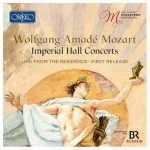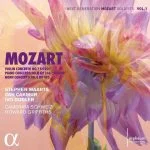
Composer: Wolfgang Amadeus Mozart
Performer: Michael Rische
Orchestra: WDR Sinfonieorchester Köln
Conductor: Howard Griffiths
Format: FLAC (tracks)
Label: Profil Medien
Catalogue: PH09006
Release: 2009
Size: 194 MB
Recovery: +3%
Scan: cover
Piano Concerto No. 20 in D minor, K. 466
01. I. Allegro
02. I. Cadenza (by M. Rische) – Coda
03. II. Romance
04. III. Rondo: Allegro assai
05. III. Cadenza (by M. Rische) – Coda
06. I. Cadenza (by F. Busoni) – Coda
07. I. Cadenza (by J. Brahms) – Coda
08. I. Cadenza (by J.N. Hummel) – Coda
09. I. Cadenza (by L. van Beethoven) – Coda
10. III. Cadenza (by F. Busoni) – Coda
11. III. Cadenza (by L. van Beethoven) – Coda
12. III. Cadenza (by C. Schumann) – Coda
13. III. Cadenza (by F.X. Mozart) – Coda
Of all Mozart’s twenty-seven concertos, No. 20 remains particularly memorable for the attention that it attracted from other composers/pianists. Beethoven often performed it and even composed his own solo cadenzas for it. Mozart had not written his own cadenzas but had only improvised them at performances. Brahms, too, knew the work, and composed cadenzas. These are just two of the interpretations that feature on this disc, performed by the pianist Michael Rische.
Mozart’s Piano Concerto in D minor, K. 466, has, to use pop parlance, never fallen off the charts; of all Mozart’s concertos it was likely the one most often performed over the course of the nineteenth century, and it’s still among the most popular works in the concerto repertoire. It has attracted a great variety of cadenzas for its first and third movements, many of them by the big names among composer/pianists from subsequent eras, beginning with the young Beethoven about 10 years after the fact. The work, thus, is ideal for this rather unusual project by German pianist Michael Rische, who records the work itself, with first-movement cadenzas by Busoni, Brahms, Hummel, and Beethoven, and third-movement cadenzas by Busoni, Beethoven, Clara Schumann, and Franz Xaver Mozart, son of the composer. In addition, the intact reading of the concerto itself is furnished with a pair of Rische’s own cadenzas, which draw on twentieth century idioms. Those are not atonal, but they veer around various idioms of a century ago without losing sight of Mozart’s thematic material. The most interest lies in the cadenzas from the nineteenth and early twentieth centuries. Beethoven’s are not terribly well-known pieces, but they’re terrific slices of the young Beethoven’s brash and ambitious personality, plunging almost immediately down seemingly foolhardy harmonic avenues. The two Busoni cadenzas, too, are entirely characteristic of that composer’s musical language. The finale cadenza by F.X. Mozart is the only to stick to the original concerto’s arpeggio figure. The additional cadenzas are stacked up sequentially after the complete performance of the concerto, but the pauses are lined up in such a way that you can hear the concerto with any cadenzas desired if you program your player with the right sequence of tracks; each cadenza track includes the final chords of the movement, as well. (You may have to tweak your pause settings if you’re listening to the album as a set of downloadable tracks.) Rische’s performance itself, on a modern piano, is sensitive and straightforward. He doesn’t have the last word on this experiment; it would be interesting to record the same cadenzas with period-appropriate pianos, and a fully improvised cadenza or two might have been a valuable addition inasmuch as it’s entirely possible that Mozart’s original cadenzas are missing because he never wrote them down in the first place. Nevertheless, this unusual release will satisfy the curiosity of many listeners.



